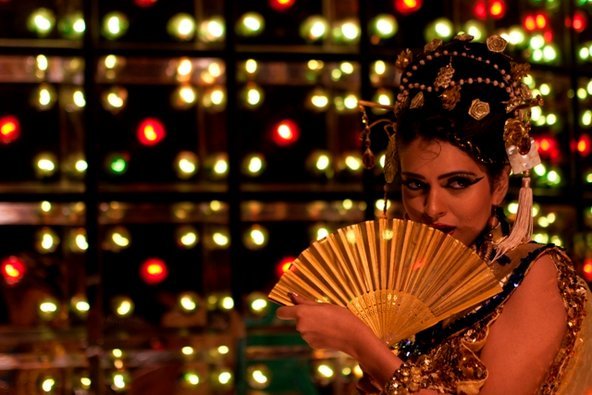
Actress Niharika Singh in a still from the film ‘Miss Lovely’.Credit Courtesy of Futureeast productions
BANGALORE — For the director Ashim Ahluwalia, “Miss Lovely,” his movie about the soft-core pornography business in Mumbai, has led to a series of delightful surprises: Last year, it won the award for the best film at the 14th Mumbai International Film Festival, the award for best feature film at the 11th Indian Film Festival of Los Angeles and was included in the Un Certain Regard section at the Cannes Film Festival.
But one of the biggest surprises was getting the approval from the Indian censor board for a mainstream release of “Miss Lovely” – something the director, who was recently interviewed by phone and email, thought would never happen.
“In India, you barely see a kiss on screen,” Mr. Ahluwalia said from Mumbai, where he is based. “It’s a highly censored country. Initially, when I sent Miss Lovely to the Censor Board, they asked me: ‘Are you sure you want to put this through?’ ”
“Miss Lovely” opened in India on Jan. 18 to an enthusiastic response from critics. Mr. Ahluwalia declined to reveal the box office figures for the opening weekend, but he said viewers wrote to his production company praising the film, a development that the director described as “staggering.”
“For a pretty wild art-pulp film with a lot of controversial content, the reaction has been incredible,” Mr. Ahluwalia said. “It’s a small film with no studio or Bollywood personality supporting us — it was released through a small independent distributor, which is very rare in India.”
“Miss Lovely,” shot documentary style, follows two brothers who are in the sex-horror movie industry of mid-1980s Mumbai, then known as Bombay. Before the Internet made pornography easily available, people lined up for morning shows to see these sleazy movies in standalone theaters in the seedy areas of Mumbai.
Since the filmmakers were dealing with pornographic content – illegal in India then as well as now — they were committing crimes on a daily basis. “Fleshing out the idea of a criminal filmmaker, who is at the bottom of the social and professional hierarchy, was fascinating to me,” he says.
Mr. Ahluwalia had wanted to shoot a documentary on what is known as the C-grade movie industry in India, but the people involved in this business refused to talk to Mr. Ahluwalia.
“Most of them had gangland connections, and their work overlapped with actual pornography,” he said. “I was kind of depressed about having all this research and nothing to do with it. Eventually I just wrote a fictionalized script out of these characters and stories.”
He didn’t want to completely abandon the documentary format, however. “I’m interested in hybrid forms because the times we live in are hybrid. Our media has mutated — we read books on our cellphones, and we use rotary telephones as nostalgic decoration,” he said.
To re-create the vibe of those early sleaze films, Mr. Ahluwalia hired the horror makeup artists, the costumers and the choreographers who worked in the industry back in the 1980s. “I didn’t want to hire hipsters that would try and emulate that space; I wanted the original crew of those films – many had been retired for decades and were stunned that anyone would pay them to do this again,” he said.
His commitment to authenticity meant that special effects makeup was done the old-school way, with common kitchen ingredients like flour, dough and ketchup, never latex or plastic.
Mr. Ahluwalia also incorporated real-life sequences into the film, like shots of ordinary men who happened to be fighting on the street or in a garishly litflophouse. “It was better than anything in the script,” he said.
For a year prior to the film’s release in India, Mr. Ahluwalia began wrangling with the censor board, which initially suggested over 100 cuts. The censors found the language to be inappropriate, the nudity to be inappropriate, the cat fight between two female characters to be demeaning to women, and the list of objections continued from there.
Mr. Ahluwalia went before the censor board to argue against the proposed cuts. Eventually, he said, he was able to convince the censors that his movie wasn’t porn and wasn’t denigrating women. “The censor board is willing to be convinced if it is done the right way,” he said.
“They finally let it through with a few blurs on the nude shots, but otherwise it was uncut,” he said. “However, many multiplex chains still refuse to run the film or the trailer despite it having an ‘A’ certificate.” The movie was shown on 400 screens in India, compared to the 1,000 for a Bollywood feature.
Mr. Ahluwalia said that once his movie was approved for a release, he had braced himself for a negative response from the public. “I actually expected everyone to hate it because it’s a dark, fairly twisted film with an unconventional narrative style,” he said. “It’s a pretty ruthless take on Indian sexual hypocrisy, and it doesn’t judge the characters as being terrible.
“I think many people realized that they needed to support the film; otherwise you would never have filmmakers like me even trying to get a mainstream release,” he said. “It was an experiment but it really worked for us.”
Published in: The New York Times
Published on: January 24, 2014
Link: https://india.blogs.nytimes.com/2014/01/24/the-journey-of-miss-lovely-from-cannes-to-the-censors/

